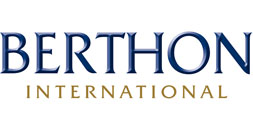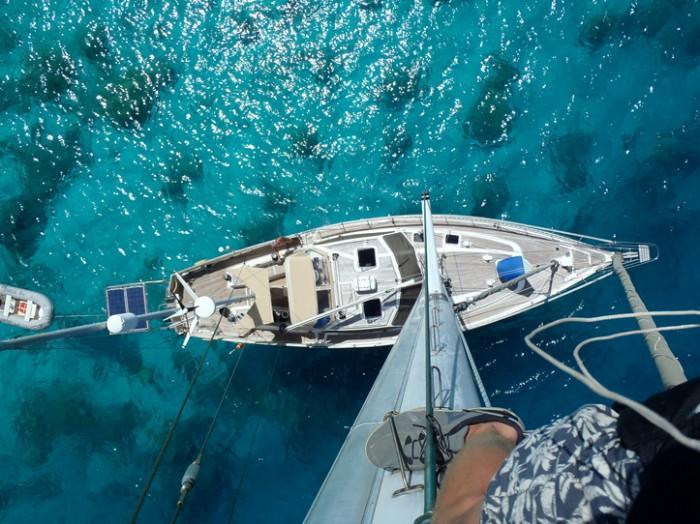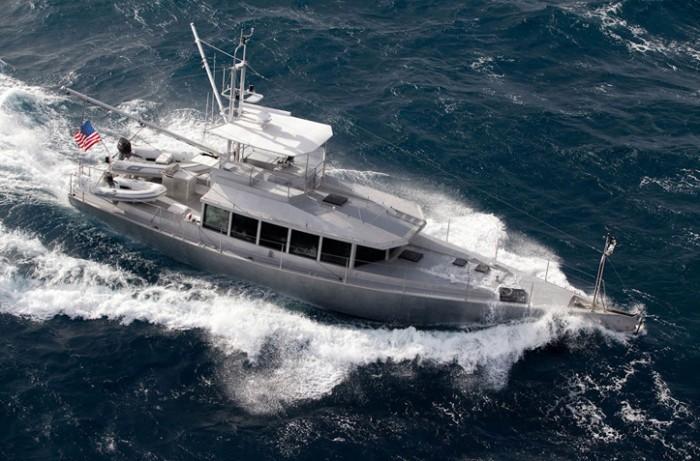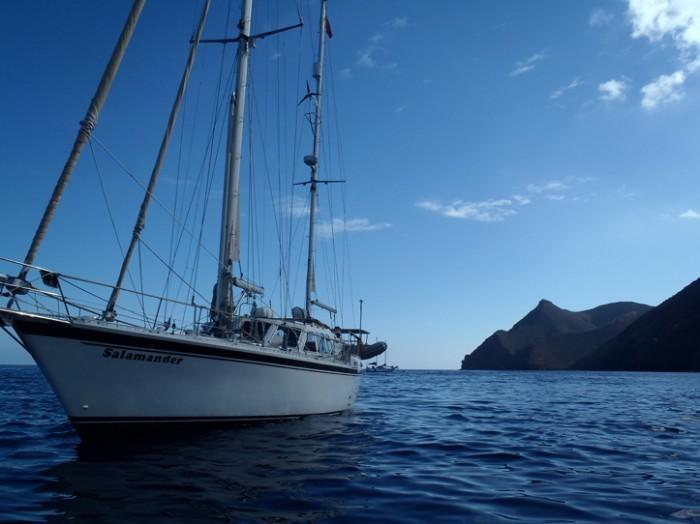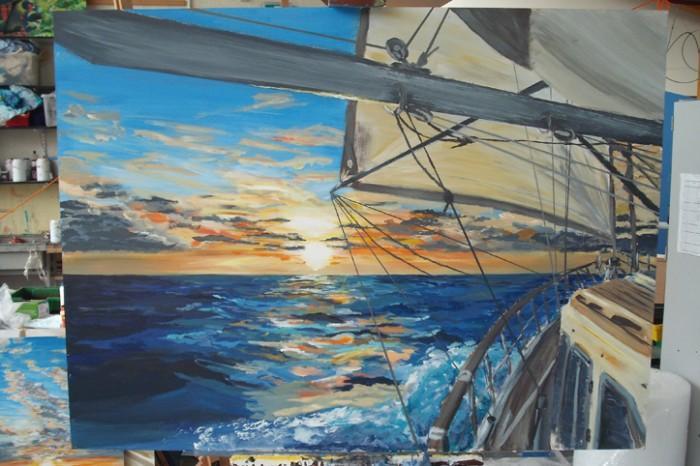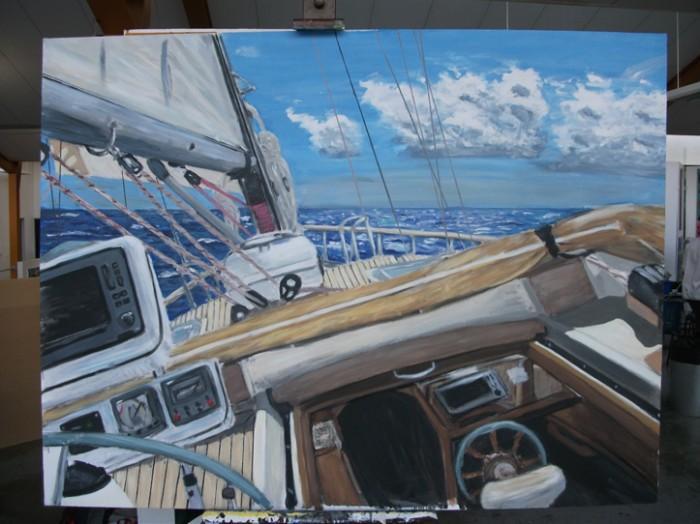Your Local Broker, Internationally
Berthon UK
(Lymington, Hampshire - UK)
Sue Grant
sue.grant@berthon.co.uk
0044 (0)1590 679 222
Berthon Scandinavia
(Henån, Sweden)
Magnus Kullberg
magnus.kullberg@berthonscandinavia.se
0046 304 694 000
Berthon Spain
(Palma de Mallorca, Spain)
Simon Turner
simon.turner@berthoninternational.com
0034 639 701 234
Berthon USA
(Rhode Island, USA)
Jennifer Stewart
jennifer.stewart@berthonusa.com
001 401 846 8404
The SALAMANDER Adventure
September 2nd, 2013
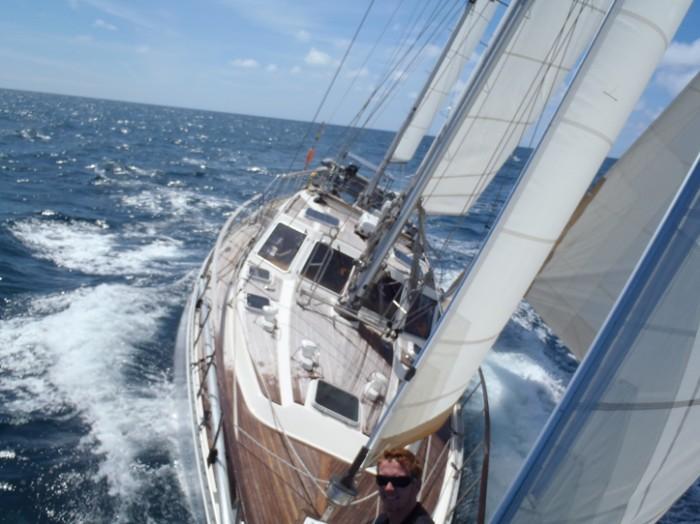
We did it, but we didn’t plan it.
We knew Salamander, a 1987 Sparkman and Stephens 52ft Nauticat 521, could do it, but could we? It took 9 months to prepare Salamander and ourselves, a family of four novice sailors. We returned to Lymington three years and 35,000 nm later having circumnavigated the world and having had the time of our lives.
As a family from when the children were age 5 and 7, we had been used to arranging our own adventures in far flung places, from Cuba and Central America, to Africa and the Far East. The only disease we ever picked up from desert or jungle had been the “Travel Bug”. As the children grew older and air flights were becoming a more significant cost we realized our children had been relatively immune from European experiences.
What to do to remedy this? A motorhome seemed a good idea, but it would have to be large enough to give each of us corners in which to read a book during rainy days. In 2006, we found just the motorhome, a 40ft American RV. It was great in every respect from overall size to the huge 4-door stainless steel fridge freezer. There was however a hurdle to overcome before we could take delivery of our new motorhome. HGV licences! Sounds easy, but being both past 50, we both had to undo all the bad habits wilfully gained, whether driving a car or riding a motorcycle, in order to pass the justifiably rigorous HGV test.
We loved the space and appreciated the freedom which the RV gave us. We used it during every school holiday from Easter 2006 through to the summer of 2009, by which time we had travelled 46,000 miles in England, Scotland and in mainland Europe from Norway in the north, to Morocco in the south, and from Portugal in the west, to Greece in the east, and most countries in between.
In 2008 we went a step further, sold our house and aimed to take a year off travelling full-time in the RV, effectively taking a break from our respective 30 year old careers. We agreed with our children that part of the proceeds of the sale of the house would finance the remainder of their school education. They changed schools and were to join us in Europe, wherever we were, every half-term and end of term holiday. They became expert young and independent budget airline travellers.
The “Travel Bug” symptoms were to get worse.
In the summer of 2009, when in Brindisi, in the south of Italy, we learnt that some former neighbours were to learn how to sail with Sunsail in the Ionian in northern Greece. It would be easy to get a ferry to Igoumenista, drive down and meet up with them there. Better still it occurred to us, we could get there early and see if we could also arrange some sailing lessons for ourselves with Sunsail. Our combined experiences to date were 2 yrs as a dinghy passenger, as a young child, and a couple of weekends crewing on an old gaffer, as a young adult.
However, turning up as we did in our RV, Sunsail were unable to oblige us with any lessons. We arrived on our motorcycle the following day, hoping to see a different person behind the desk and to get a different response. Fortuitously, as it turned out, they were still unable to offer any sailing lessons. Fortuitously, perhaps, because instead we found Odysseus Yachting, a very friendly and helpful local yacht charter company just up the road in Paleros. We arrived in their office on a Thursday asking if they had a boat available for the weekend. The quick response was “give me 20 minutes”, a well used and often abused phrase. But on this occasion in less than 10 minutes we were called back and told “Hi guys, we have a boat for you, a 44ft Dromor, it is currently in Corfu and can be brought down overnight. Would you like it brought down for you?” Following our response, “Sounds great”, we were asked about our sailing experiences, to which we replied “None”. This was followed by “Ah, then you will need a skipper, and I have just the right one for you. You will get on with him really well.” We confirmed this was ideal as we wanted to learn how to sail.
It turned out that our skipper had left Paxos in his twenties and sailed around the world for 18 years in a 27 ft sailing boat, packed to the gunwales with dried feta and olives. Only when asked would he give any clues as to his travels. We enjoyed his company, learnt how to sail and began to dream perhaps of our own sailing adventure.
The following week we socialised with our former neighbours in the evenings during their shore-based week. Understanding that the following week they were to be away spending a week afloat on flotilla, we went back to our newly found friends, Lisa and Dimitris, at Odysseus Yachting and reminded them of their earlier confirmation that if we got on ok with our first week’s charter with a skipper, we could, hypothetically of course, return the following year and charter a boat without a skipper. So we asked once again “do you have a boat for the weekend?” which was immediately followed by the now familiar “give me 20 minutes”. This time we were offered a 39 ft Beneteau Oceanis, and yes, it was agreed we didn’t have to have a skipper.
We enjoyed our second week sailing by ourselves as a family, making the most of the available wind to visit delightful Greek anchorages and small harbours.
It became apparent that a sailing boat could take us so much further than our motorhome. Our six rubber tyres required smooth tarmac for a comfortable ride, and we had just about found the geographical limits of smooth tarmac. But a sailing boat, were there any limits?
Upon our return to Paleros, at the end of the second week’s sailing, we bumped into our original skipper in a taverna and asked for his advice when choosing a boat, if we, as a family, were to consider any further sailing adventures. He quickly confirmed he had been mad to set sail in a 27ft boat on his adventures, and suggested that we should look at Scandinavian long keel ketches built in the 1980’s, in the 40 – 50 ft range, for overall strength and suitability for ocean passages.
In the following weeks we looked at a number of boats in Greece, but none of them appeared suitable. Our son meanwhile had spotted on the internet that Salamander, a 1987 52ft Nauticat long keeled ketch, built in Finland, was for sale at Berthon, which appeared to meet all the Greek skipper’s suggestions.
We were due to return to the UK in our RV in September 2009, completing our original plan for a year’s break from work.
Before returning to the UK from Greece we called Berthon to enquire if Salamander was still for sale, to be told it was. A couple of days later we arranged to come to Berthon in Lymington directly from the Channel ferry, agreeing with Berthon that it would be perfectly OK to arrive late at night and park up in our 40 ft American RV. We then made a further call, from the channel ferry, to a good friend who lives near Lymington, and asked if he was interested in meeting us on our arrival in Lymington. Further to our response to his questions as to why we were coming to Berthon and what we were coming to look at, he went on to confirm he had already sailed from Berthon on a boat of his, and that only a few months ago he had now bought another boat, a Nauticat and it was berthed at Berthon!
Following our late evening arrival we met our friend and just had time to look at his much newer Nauticat, both inside and out, then we sneaked a look at Salamander on the hard from the gantry, before retiring for a pint of warm English beer in the King’s Head.
We completed the purchase of Salamander a month later in October 2009, understanding there was much work to do to bring Salamander up to scratch and much further training to bring ourselves up to scratch.
We enjoy projects having fully restored our 1840 house in London in nine months in 1989. Salamander required an extensive refit. We chose Berthon and planned to do some work ourselves in tandem. The boat was to become another restoration project. Berthon were happy that we could get as involved as we liked in this latest project and everyone welcomed the opportunity for us to familiarise ourselves with the workings of Salamander in preparation for whatever adventure we might have in mind during the works.
Before hauling out in late autumn for the refit the family undertook practical RYA lessons on board Salamander with Matthew Fordham, of Sailing Ventures, a well run family Solent sailing school, together with VHF and First Aid courses back at their base on shore. By special request our first day was spent pontoon bashing, with two of us attempting to dock Salamander for the first time, bow in and stern in. As we sailed that autumn in the Solent we firmed up the initial list for the refit. From our RV experience we were clear we wanted to be self sufficient, so solar panels, wind generator, heating, water maker and generous refrigeration were thought to be important; all in addition to the requirement to replace the ageing teak decks and the old standing rigging, to fit new chartplotters and electronics at both helm positions, new davits and swim platform etc., etc.
We followed surveyor’s recommendations, ARC requirements and more.
We also followed Peter’s advice at Sander’s Sails to replace all the old clearly delaminating sails with new, using Vectron, a tough sail suitable for long distance cruising. A full set of new matching canvas was also ordered.
During the early part of the refit we were able to continue living in the RV in the car park by the marina wall. This enabled us to assist by removing all the deck fittings prior to removing the old deck itself. During the refit two of us continued with our training and went on an intensive residential Yachtmaster navigation course on the Isle of Wight organised by Sapphire Yachting. We also visited the Boat Show in Düsseldorf in 2010 and introduced ourselves to Kaj Gustafsson, the managing director of Nauticat Yachts and thanked him for supplying various original new parts for the refit, including the new swim platform and ladder.
Odysseus Yachting was at the Boat Show as well, so we couldn’t resist catching up over dinner with Lisa and Dimitris and blaming them for having put us in the position we now found ourselves of owning a 52ft sailing boat and refitting it for adventures unknown.
We planned to leave the UK for the Mediterranean during the summer of 2010.
Salamander was back in the water in the late spring 2010. Each weekend thereafter we took her out for a 2 day shakedown to test new systems whilst work on the refit continued during the week. We were keen to experience a night passage across the Channel with Matthew, our instructor, to overcome any apprehensions we might have for crossing busy shipping lanes at night. So it was arranged during one of these shakedown weekends in late May to sail to Cherbourg at night and return the following day, which conveniently completed our Coastal Skipper qualifications. We still recall the wonderment of that first night passage under a moon interpreting aloud ship’s pin-prick lights in the distance, AIS and Radar information on the chart plotters and judging how close it was safe to pass these big ships, as the lights grew bigger and the ships came closer. Meanwhile our children had qualified as Day Skippers with Matthew during the Easter school holiday.
Eventually we left Lymington with our son, who had just finished his GCSE’s, in mid July to cross Biscay. Our daughter had just commenced her gap year and was already in Spain celebrating the end of school and arranging to meet us in Vigo, our first landfall since leaving Lymington, and continue with us as far as Malaga before going on to pursue her own gap year plans. Our son left us from Ibiza to return to start his sixth form at school.
We were to experience a number of coincidences. The first was in Palma in Mallorca to be instructed by the marina to berth alongside Linda and Steve Dashew’s Windhorse, which had been on the hard for the winter at Berthon. Linda had freely given some useful advice to us and introduced us to the Dashew’s informative website SetSail.com for cruisers, when she was in Lymington, and recognizing us again invited us on board Windhorse.
After Mallorca we returned to Gibraltar as our latest plan was to cross the Atlantic in mid December with our son having arranged for him to have an extended Christmas holiday from school. Anchored at La Graciosa, in the Canaries we met other cruisers planning to cross the Atlantic from the Canary Islands. Our daughter’s gap year plans to cook and ski in France were suddenly frustrated by a head injury encountered on a cooking course in September, followed by surgery in December. Her surgeon advised against skiing. She decided instead to join us and was back on board in mid January for a delayed Atlantic crossing with us instead of our son who returned to school.
The Atlantic Ocean crossing was to be our first ocean passage and we readily accepted we required experienced crew to help us, particularly as we had no idea how our daughter was to react to an ocean passage after head surgery. We had shared a coffee with a Yachtmaster instructor in Gibraltar and were pleasantly surprised when he answered a month later our request for crew on the internet. He introduced one of his former pupils, now also a Yachtmaster, as further crew.
Once clear of Lanzarote we had no further need of the engine, as the wind picked up behind us all the way to Grenada, with winds never less than 20 knots, usually in the 30’s, with sudden line squalls gusting in the 40’s. We had experienced 30 knot winds in the Solent, but nothing had prepared us for the waves in the Atlantic Ocean. Our log book confirms 3 to 4, occasionally 5 and very occasionally 6 metre seas, every day from behind. Salamander had a great passage taking 18 days. It took at least two or three days however for the three novices amongst us to understand this was what Salamander had been designed to do, after which time we began to learn to relax and to start smiling at the tall glassy, see-through waves approaching us from behind, before the dancing tops broke in a cascade of white water. We established a new Salamander record as the odd wave caught us, picked us up and carried us forward surfing at 18 knots. For a 1987 long keeled ketch, weighing nearly say 30 tonnes with our fuel, water and stores, and her novice crew this was an amazing and unforgettable introduction to ocean sailing.
Another coincidence, when in Port Louis Marina in Grenada, was to find ourselves berthed not three boat lengths away from two boats we knew, Truant (a Nordia 55) and Endeavour (a Challenge 67), both of whom we had tied up against for a number of weeks at the work pontoon back here in Berthon.
The “Travel Bug” had now bitten hard.
After a successful Atlantic crossing, a short family conference in Grenada determined the future plan. We had bought Jimmy Cornell’s World Cruising Routes, as a coffee table or saloon book for discussion, just before setting off across the Atlantic. Everything was clearly laid out within that book for a further adventure.
So with spirits high, new reference books, new pilot guides, further paper and electronic charts to hand the Pacific Ocean beckoned. One of the volunteer crew left us for St Maarten after handing over a video he had recorded of our Atlantic crossing. We sailed on to Bonaire with an unscheduled pit stop for a car accessories shop in Curacao to replace a relay on the auto pilot, which had failed the night before.
Our next stop was Shelter Bay, Panama where we were corralled with other yachts to be measured for the transit of the Panama Canal. Many long lasting friendships were made whilst waiting for the transit. We were to bump into these friends time and time again at different anchorages during our passage of the Pacific. Our son had joined us for his Easter holiday, enjoying an open-air Shakira concert in Panama City with his sister together with some recently made Canadian teenage sailor friends. He flew back to school from Contadora in Las Perlas, islands off the coast of Panama, on the Pacific side, while three of us sailed on to Galapagos where by mutual consent our one remaining volunteer crew left us to become skipper of another boat.
From Galapagos onwards we agreed Salamander was to be a family run boat once again. We had gained a lot from the experience, help and never ending enthusiasm offered by our volunteer crew during the Atlantic crossing. We doubt whether we could have done it without them. It was to prove to be an invaluable lesson for later ocean passages.
Our first ocean passage without outside help from Galapagos to the Marquesas was an enjoyable and straightforward passage of 19 days, with little use of engine, arriving in Hiva Oa to be greeted by friends made in Panama and Galapagos, enquiring after our first solo passage.
We went on to visit Ua Pou and Nuka Hiva, in the Marquesas, then Kauehi, Fakarava and Toau in the Tuamotus, before our son joined us again in Papeete, Tahiti for the start of his summer holidays. The four of us sailed together visiting Moorea, Huahine and Bora Bora in the Society Islands, Suwarrow in the Cook Islands before arriving in Vava’u, Tonga where both our son and daughter left for the UK for school and university respectively.
Our daughter leaving meant not only had we lost a valued crewperson, who had sailed with us from the Canaries, across the Atlantic and most of the Pacific, someone who you were more than happy to leave alone on night watch in all weathers, we also lost the best cook we ever had on board Salamander. Her home cooking, including biscuits, cakes, muffins, focaccia, provided amazing unscheduled treats for us.
In Vava’u we reluctantly accepted an invitation, considering ourselves novices, to crew with friends on a Jeanneau 54 for 3 races in the Vava’u Regatta. Although not a serious regatta we were surprised to have enjoyed it so much and even more surprised to come second in two of the races, thanks to the shrewd racing tactics and skills employed by our Swedish skipper and his Australian wife, who dared to race their cruising home.
Sailors are obliged to make a decision before leaving Tonga whether to stop either in New Zealand or Australia, or opt instead to carry on, entering directly into Indonesian waters or the Indian Ocean, to avoid the cyclone season. We had friends in both Australia and New Zealand we wished to visit, and decided upon Australia simply on the basis that it would be warmer than New Zealand.
Visas for Australia are required and were finally obtained after 2 days form filling on line with a dodgy internet connection in an open-air café in Vava’u. We, just the two of us now, sailed on stopping at Fiji, Vanuatu and New Caledonia before arriving in late October at Port Bundaberg Marina in Australia, our first marina since leaving Panama City.
We made the decision to berth Salamander in Bundaberg for the cyclone season, rather than to sail further south, possibly as far as Sydney, preferring instead to visit old friends by car in the Central Highlands of Queensland and new Australian friends made during our Pacific crossing, who had returned to their East Coast homes or berths after their various circumnavigations or passages from Europe and America.
It was interesting to note at the time that nearly everyone we talked to towards the end of their Pacific crossings was looking forward to a break. Sailing across the Pacific had been fantastic, visiting different islands and remote coral atolls and the sense of achievement we all felt was only marred by the ease with which we could navigate across the Pacific and choose which atoll or island to visit next, thanks to the chart plotter and the embedded electronic charts. Hats off to those not so long ago who did not have chart plotters and to those even longer ago who had no electronics whatsoever. It is not for nothing that the numerous widely spaced, low lying palm fringed atolls, barely rising above the level of the sea, the Tuamotos, were called the dangerous islands.
What is even more dangerous now however is to be able to browse one’s own electronic charts under the stars on night watch, fascinated by the navigation readily found on these charts to round South America, by the Strait of Magellan or how about a North Pacific loop to Japan and Alaska? Every long distance sailor we met, who had done it, says you can’t beat Tierra del Fuego and Alaska!
It was good to have a break, to stay with farming friends in the Central Highlands in Queensland, to return to the UK to catch up with extended family and friends and then to fly back to Sydney with our son and daughter to spend a Christmas holiday touring Australia by road and staying with our new and old Australian friends. We wanted to see the interior of this immense red country and believed we would understand it better if we drove into the centre rather than to take an easy hop on a plane. Setting off from the East Coast it took three days, driving long days on mostly empty roads to reach Uluru, or Ayers Rock as it used to be called. It was worth driving 15,000 km, sometimes on dirt roads, to see the outback, a real contrast to the modern face of Australia.
Part of our enforced stop in Australia, while waiting for the cyclone season to pass, was spent upgrading Salamander’s interior lights, applying three further coats of antifoul and seeing to any minor repairs required, to prepare her for the second half of what was to become her circumnavigation.
During this stop we also flew to New Zealand and toured South and North Island by camper van, stayed with old friends in Auckland and visited new sailing friends berthed in Whangarei and Opua in North Island, who had opted to stay in New Zealand rather than Australia. Seeing the Volvo 70 In Port Race from our friend’s motor boat in Auckland Harbour with the Volvo 70’s noisily tacking close by and around us and seeing the start of the next leg of the race to South America gave us a unique insight into sailing at this high level. Some of these boats we were to see again back here during Cowes Week and at the start of the Fastnet Race a year and a half later.
We returned to Bundaberg to carry out some final preparations before leaving for the Whitsundays and Airlie Beach, where we had arranged to meet our daughter, who was to spend part of her summer holiday with us sailing inside the Great Barrier Reef and the Gulf of Carpentaria to Darwin.
In Seisia, in the far NE of the Gulf, just around the corner from Cape York, when motoring our rib to shore for a coffee and some provisioning we dodged a floating log which completely disappeared from sight just as we were about to run over it. It was in fact a sizeable crocodile, as confirmed by the terrified screams at the front of the rib. We spent longer than usual finishing our coffee that morning before returning to Salamander later in the day.
In Darwin we had a change of crew as our daughter flew back to the UK and our son joined us to spend his gap year sailing with us from Darwin back to the UK. It took us four days motoring to escape the wind shadow of NW Australia before we could continue sailing to Mauritius via Christmas Island and Cocos Keeling.
Our son’s arrival meant more time could successfully be spent fishing on passage. We were soon to have a freezer full of Yellow Fin and Albacore Tuna, Mahi-Mahi, Barracuda and Wahoo.
The approaches to South Africa require respect for the SW winds, the Buster, when, not if but when, it blows, and it blows every few days, which is against the direction of flow, SW, of the Agulhas current, which lies between 12 nm and 100 nm offshore in bands of 50 nm wide. Books warn of the danger of the SW winds blowing and producing steep dangerous seas and the simple guidance NOT to cross the current when the SW winds blow. Steep waves of more than 10 metres have been regularly recorded.
We were looking to reach South Africa further south, rather than to take the shortest crossing direct to Durban, subject to weather as always, to make up time to meet our daughter in Cape Town and to be ahead of a fleet of boats in a rally who were taking all available moorings between Durban and Cape Town. This might entail weathering a Buster in the Indian Ocean outside the Agulhas current, which we mentally prepared ourselves and Salamander for.
Notwithstanding the above wish to take a short cut if at all possible, we planned to continue heading towards Durban until 2 days out, when we might be relatively confident of a 2 – 4 day forecast, before taking the decision to alter course to take us further south.
The weather was benign leaving Mauritius and when passing Reunion.
Thereafter we were to experience every point of sail and every sail plan, from running with poles, to broad reaching, beam reaching and close hauling. Previous passages were remembered for setting the sails at the beginning of the passage and only ever tweaking or reefing them during the passage.
Two days away from Durban we agreed to alter course and head for Port Elizabeth, understanding we would have to weather the Buster in the ocean off-shore before entering the Agulhas current. We knew from our SSB grib forecasts and from talking to Peri-Peri, a volunteer radio net based in Africa, when the Buster was due and where.
So to do this we were obliged to slow Salamander down to remain well off-shore and outside the Agulhas current. This was not exhilarating sailing, tacking downwind trying to average 4 knots or less for 2 days in good winds of 15 – 20 kts, in order to remain behind a safe holding position we had plotted, when the Indian Ocean current by itself was pushing us relentlessly towards the holding position at a rate of 1 1/2 to 2 kts.
In fact we spent some time sailing in the wrong direction to avoid arriving too early.
Sure enough the Buster came more or less on cue, blowing 30 odd knots, which is not that much of a blow. The waves were 3 – 4 m high, occasionally 5m. Again not huge seas, but the wind was against the ocean waves and swell, resulting in a very short steep confused sea.
Salamander was being picked up by each wave, sometimes with the bow digging into the next wave before having a chance to rise again. But the real experience was see-sawing. Salamander is a heavy boat with a long keel, which is great for directional stability. So to pivot or see-saw on each crest of a wave, from where you could not see down the far side of the same wave, such was the steepness, with both the bow and the stern out of the water at the same time, was new to us. One moment pointing at the sky, looking at the steep wave, the next tottering on top of the wave, unable to see the far side of the wave, the next pointing downhill into the next wave. Two of us remained by the helm close hauling into the wind on autopilot, wearing full ocean gear for the first time since crossing the Atlantic with safety harnesses tied on, being alternatively grit blasted by storm driven salty spray or simply deluged by a full wave in the face for 12 hours or so. We looked at and assessed each individual wave rushing towards us ready to take immediate action as and when required should we hear the autopilot alarm.
Action required? None. Salamander dealt with it fantastically, albeit juddering noisily, and the crew was taken to a new and higher level of understanding.
Looking back it was great. In the beginning it was fearful. The daytime sky was nearly black. The noise was horrendous. Throughout Salamander was played with as if she was a mere windsurfer, rather than a near 30 ton yacht, but she kept her course magnificently.
Next consideration, having weathered the Buster, was to consider proceeding beyond Port Elizabeth, to Mossel Bay, which was further around towards the Cape, before the next Buster was due. The weather was looking good, so the decision was made to alter course again and head directly to Mossel Bay.
We were now safe to traverse the Agulhas Current and experienced up to 5 kts of current for several hours in our favour, enabling us to make 12 kts.
Another much stronger Buster was due in two days with predicted winds of 40 plus kts. Ideally we did not want to be on anchor watch in 40 plus kt winds. It was time to continue towards Cape Town and aim to get there before the winds were due. We brought forward our plans by 6 hours and left the anchorage at midnight. It entailed some motorsailing, since we could not afford to lose any time in getting there. In fact we motorsailed in a glorious gently rolling 3 m swell, making over 8 kts, seeing huge numbers of dolphins, seals, whales, the odd albatross and a spectacular sunset on the eve of the Buster itself off Cape Agulhas, where the warm Indian Ocean meets the considerably colder South Atlantic Ocean.
The notorious Capes, Agulhas and Good Hope, were benign. Large swells as expected, but really rather pleasant, other than the constant doubts as to whether or not we would get to Cape Town before the strong winds were due on the nose.
We arrived before the storm, now forecasted to reach 45 – 50 kts, reflecting on how lucky we had been gaining shelter in the Waterfront Marina in Cape Town in time. Listening in on VHF Ch 16 however later that evening we heard captains of the large commercial ships reporting 60 kt winds outside, some reported dragging their anchors and deciding to lift anchor to weather the storm at sea. We were snug in the well sheltered modern marina. This passage has been another eye opener for us, understanding still further what Salamander and the crew can endure.
Our daughter joined us again in Cape Town in mid December and this Christmas holiday was spent touring Southern Africa by bus to Namibia and the Victoria Falls in Zambia, then foot ferry across a muddy river to Botswana, where we hired a 4 x 4 to drive ourselves through Chobe National Park along 400 kms of poorly signposted sand tracks for two days, to spend Christmas Day in a remote camp site with sandwiches for Christmas dinner and free range wild elephants wandering around. Newly acquired sailing skills proved essential as we became lost with inadequately painted or faded arrows on rocks as sign posts, no mobile signal, no sat phone, no residents other than passing wild giraffe, elephant and buffalo, and no passing wheeled traffic at all throughout the day, with whom we could discuss directions. We did have the recommended and best available map, a pictorial map produced by Shell, of the vast Park. Although the map was poor it was at least bordered with lat and long scales, so with a mobile phone with a GPS function confirming our lat and long, we plotted our position every half hour, and retraced our route a couple of times to take an alternative track until we found the remote camp site at the end of 8 hours driving on tracks and soft sand river beds. Another hazard was to find tracks obstructed on half a dozen occasions at least by an elephant carcass. The policy in Botswana was to leave all dead animals to rot where they fell to become part of the natural food chain for others. From a navigational point of view you can smell an elephant carcass well before you see it on the track!
After taking a dug out canoe through the lily strewn Okavango Delta it was time to drive on to Johannesburg, via a Rhino Sanctuary and an overnight stay at a Cheetah Reserve, to drop the 4 x 4 off and take our booked seats on the train on the scenic route back to Cape Town.
In early January our daughter flew home, as we set sail for Salvador in Brazil, arriving in time for the Carnival, after calling in at St Helena on the way. The South Atlantic crossing was sublime. The cruising chute stayed up continuously for three days and three nights in calm seas. St. Helena does not have an airport and so any visitor must arrive by sea. Indeed we were greeted by the friendly harbour master at the quay who escorted us personally to the customs and immigration offices to check us in. In a café guest book we searched and found an entry for the 23rd May 1995 for an earlier visit of sailing vessel Carina, Salamander as she was named by her first owner. Salamander had been here more than once before, sailing from her first home which had been in South Africa.
After Carnival in Salvador we left for an anchorage up a river near Jacare to the north in order to visit Recife and colourful Olinda by car, before leaving Brazil for Tobago, then Trinidad. Our circumnavigation was completed when we arrived in Prickly Bay, Grenada.
From Grenada we then enjoyed comparatively short hops through the Caribbean calling at Carriacou, Tobago Cays, Bequia, Martinique, Guadeloupe and Dominica.
Upon reaching Antigua and entering Falmouth Harbour we were greeted by the crew of Truant in their rib racing towards us, who we last saw in Grenada when we shared a rum punch together, celebrating our first trans Atlantic crossing over two years before. It’s a great feeling sailing around the world bumping into friends again and it really does reinforce the feeling of how small in many ways the world is.
From Antigua we headed for the Azores. One day into the passage we were unable to use the gear box due to a seal failure. Without a spare seal on board it was not possible to fix it, although we enjoyed engineering a way to recycle the gearbox transmission fluid if the engine was required for emergency use. We decided to sail on and 24 days after departing Antigua, we reached Horta in Faial. We had hoped to sail all the way, and had looked forward to the satisfaction of entering the harbour under sail and dropping the anchor inside. However the wind died on us in sight of the harbour walls less than 2 nm away, when the tide turned to take us backwards at half a knot. We called for a tow, as requested by email some days earlier as a backup plan, and were gently towed in. Seals and gaskets were quickly flown to the Azores and the gear box fixed. An unexpected highlight, during a calm, had been to be slowly circled for 15 minutes by an inquisitive 10 metre Fin Whale, less than 2m away from the boat.
For the leg back to Lymington from the Azores our daughter flew out to join us so that we could be all four for this final passage home. We set off in late June and arrived back at the start of the English summer and were amused to be the only boat turning into Lymington River on the morning of Sunday 7 July, as most Lymington based boats were on their way out set to enjoy the beginning of the heat wave. It did not take long to feel that we had never been away.
We had not planned to take five years out of work when we abandoned our 30 year old careers and left London in June 2008. One year of travel in Europe in the RV had been the only plan.
It had certainly never been on any horizon to consider buying a sailing boat, or to learn to sail.
We took an opportunity and Salamander became another project for us. We could see the advantage of refitting and upgrading Salamander to a high level in one hit with Berthon. If we had taken the project on ourselves we would more than likely still be here getting the boat ready.
Salamander was a well built boat in 1987, and remains so to this day, and was well prepared for our adventure. The pilot house concept with two helm positions, one inside and one outside, each equipped with full instrumentation and chart plotters, was found to be a good one for all weather sailing and all round visibility, night and day, both on passage, giving us much needed protection both from the tropical sun and the wet and cold, and as a live aboard. We concluded we made the right choice with the Nauticat 521, as this suited us perfectly as a family and was much admired by sailors who came aboard during our travels.
We were really fortunate that events gave us the opportunity to share this circumnavigation with our son and daughter. We have shared together new friends and memories. Having crossed the Atlantic the first time and knowing that we had friends in Australia and New Zealand there was an added incentive to sail on to Australia and to fly to New Zealand.
We were privileged to spend time in the homes of friends old and new. We certainly did have the time of our lives. None of this however would have been possible without the support of our families and friends, and the help and advice given freely by Odysseus Yachting, Sailing Ventures, Sapphire Yachting, Nauticat, SetSail, Sanders Sail and of course Berthon.
What next?
…. We have no idea.
Is Salamander ready to go off again?
…. Yes, no doubt about it!
Can a permanent cure be found for the “Travel Bug”?
…. Not sure.
Having, we feel, made all the right decisions so far, we are now in a quandary, not knowing what to do next. Should we sell Salamander so that someone else can take the opportunity to go on an adventure, while we think of something else, or should we keep her for another sailing adventure to parts as yet unknown for ourselves?
The crew of Salamander 2013.
………………..
Any comments for the crew of Salamander, please email:
thesalamandersailingadventure@gmail.com
………………..
http://www.nauticat.com
http://www.setsail.com
http://www.sanders-sails.co.uk
http://www.cornellsailing.com/
https://www.berthoninternational.com
